 |
| Fujifilm X-S1 |
Ease of Use
The X-S1 is Fujifilm's new flagship super-zoom camera, costing a whopping £300 / $400 more than the HS20EXR model. The X in the product name denotes that the X-S1 sits alongside the X100, X10 and the X-Pro1 as part of Fujifilm's recently introduced premium range of cameras. The X-S1 has a large 2/3-inch CMOS sensor, exactly the same as the one found in the X10. This is more than twice as large as a standard compact camera's 1/2.3in sensor, which should result in better image quality, especially as Fujifilm have sensibly chosen a modest 12 megapixel resolution.
In many ways the X-S1 looks similar to the HS20EXR, looking, feeling and handling very much like a mid-range DSLR. It is quite a big bigger and heavier than its more consumer-oriented sibling, however, and indeed any other super-zoom currently on the market. Designed as a do-it-all, all-in-one solution for the serious photo enthusiast, the Fujifilm X-S1 is more than weighty and well built enough to withstand a few bumps and scrapes. The moulded curves of the DSLR-like body and textured matt black finish deliver a purposeful look that is as aesthetically pleasing as it is practical, with nice chunky controls, an ergonomic control layout that allows both quick and easy access to functions, and a deep hand-grip with a well-thought-out indentation into which a middle finger slots comfortably. This is a camera for which you will very much need to use both hands at once. The two dials on top of the camera are precision milled from solid metal, although all the other external buttons are made from plastic.
At the heart of the X-S1 is the 26x zoom lens which is made up of 12 groups and 17 elements including four aspherical elements and two ED lenses. It also has a 9-blade aperture diaphragm and comes complete with a metal lens barrel with manual zoom and focus rings, just like on a DSLR lens. This versatile lens offers a focal range starting at an ultra-wide 24mm and finishing at an ultra-telephoto 624mm. Throw in the 1cm Super Macro mode and impressive maximum apertures of a bright f/2.8 at 24mm wide-angle to f5.6 at full 624mm telephoto, and it's clear that the X-S1 is perfectly suited for virtually any subject that you can think of, near or far.
To help avoid blur resulting from camera shake when shooting in low light or hand-holding the camera at the telephoto extremity of the zoom, Fujifilm have added a 'belt and braces' solution of high ISO sensitivity, stretching up to ISO 12800 at full resolution (JPEG only), a built-in mechanical stabilizer with Continuous or Shooting Only modes, and digital image stabilisation too if required. Activated via the IS Mode menu option, you can set the system to Continuous, Shooting Only, either mode with the addition of digital stabilisation, or Off. Note that the camera will only automatically adjust the ISO speed when using the Auto shooting mode - in the other modes the ISO speed that you select will always be used, so only the mechanical CCD-shift part of the system is used.
The full 26x zoom range can be accessed in the Motion JPEG format movie mode, with the X-S1 offering full 1920x1080 pixel footage at 30 frames per second with constantly adjusting auto exposure and focus with stereo sound. It can record video clips up to 29 minutes long for the 1920x1080 and 1280x720 pixel formats, with longer times available for VGA and SVGA modes. The dedicated Movie button on the rear makes it quick and easy to shoot a movie without missing the start of the action, and there's a mini-HDMI port for connection to a HDTV (cable not supplied). You can select one of the Film Simulation modes to give your footage a more creative look, and there's the option to take a still photo at any time during movie recording.
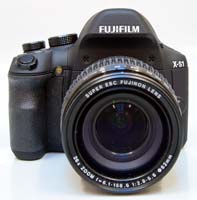 |
| Front |
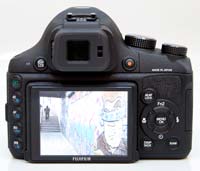 |
| Rear |
From the front the Fujifilm X-S1 looks like a serious bit of kit. The large optically stabilised zoom lens dominates proceedings, with a push-on lens cap, metal lens-hood and retaining strap provided in the box. Above the lens and extending out across the lens barrel, which boasts a textured surround allowing you to get a good firm grip and achieve a smooth, steady zooming action, is a squat ridge that conceals the small pop up flash (when not in use), which is activated via a dedicated button positioned to the right. Still viewing the X-S1 from the front, the stereo sound speakers are positioned one on either side of the lens barrel, with a familiar dual purpose AF-assist illuminator and self-timer lamp to the left. Behind the pop-up flash is another DSLR-like touch - a hotshoe for additional illumination via an optional external flashgun (EF-42 and EF-20 models). Completing the front of the X-S1 is a handy Focus Mode dial which lets you quickly choose from the AF-S, AF-C and Manual focus modes.
Looking down on top of the camera, viewed from the rear, there's a clearly labeled and logically laid out control set, with a chunky, ridged shooting mode dial which is reminiscent of those found on, yes you've guessed it, DSLR cameras. Ranged around the dial, which turns with just the right amount of resistance for it to lock firmly into place at each setting, are the expected shooting options, such as full auto, program, shutter priority, aperture priority and manual modes, along with three customisable modes (C1, C2, C3) via which favoured shooting settings can be saved for rapid access, plus a scene position mode (SP1) that's pre-optimised for common subjects.
In addition, there are several more shooting modes that are particularly noteworthy. First up is the EXR Auto mode (one of the four EXR modes), which is an 'auto everything' scene recognition mode that's the equivalent of Panasonic's Intelligent Auto mode. Although far from infallible - if you're not paying close attention and it's presented with a busy scene it will call up landscape when macro is needed and vice versa – it instantly makes the X-S1 more beginner friendly, instantly recognising 10 basic scenes and then applying one of the three other EXR modes too.
Fujifilm's EXR sensor can be utilized in one of three ways by the photographer. There's a choice between shooting at full 12 megapixel resolution in High Resolution (HR) mode, or a 6 megapixel image in the Low Noise (SN) mode for shooting without flash in low light conditions, or the Dynamic Range (DR) mode to achieve an optimal balance between shadows and highlights. The latter offers five strengths ranging from 100-1600%. If you can't decide which is best for a chosen scene or subject, then just leave the camera on the scene-detecting EXR Automatic Mode and let it choose for itself.
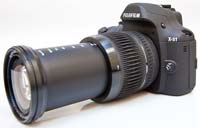 |
| Side |
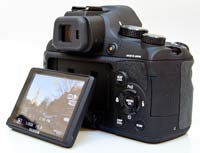 |
| Tilting LCD Screen |
The final Advanced mode is the Motion Panorama option, clearly inspired by Sony's popular Sweep Panorama function. This lets you capture a 120, 180 or 360 degree panoramic image very easily without the use of a tripod. All you need to decide is whether you would like to start from left or right, top or bottom, then press and hold down the shutter release while doing a "sweep" with the camera in hand. Exposure compensation is available before you start the sweep, with the exposure fixed once you depress the shutter button. After you are done with the sweeping, the camera does all the processing required, and presents you with a finished panoramic image.
Although undoubtedly fun, there are a few catches. The final panorama is of relatively low resolution, and if you do the sweeping too slowly, or you let go of the shutter release button too early, the panorama will be truncated. If the exposure varies throughout the scene, then some areas will be over or under exposed, depending upon the exposure value that was chosen as the panorama was started. Finally, people and indeed anything that moves in the frame are recorded as several ghost outlines, which means that you can really only record static, empty scenes, something that Sony have solved in the latest iteration of their Sweep Panorama feature.
To the right of the shooting mode dial is a smaller command dial with a positive clicking action which is used for scrolling through features and captured images, and will feel immediately intuitive to anyone who has handled a DSLR before. The same dial is also used to change the aperture and shutter speed when using the more advanced shooting modes. In the Manual mode, you hold the Exposure Compensation button down with your forefinger and give the dial a flick with your thumb to change the aperture, not quite as intuitive as having two separate command dials. Otherwise the exposure compensation button works largely as you'd expect, with a visual slider graph on screen accompanied by a live histogram.
 |
| Front |
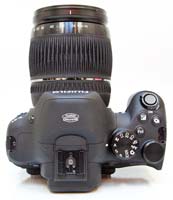 |
| Top |
Forward of these two controls is the main shutter release button encircled by the on/off power switch. Flick this to On, and the rear LCD or electronic viewfinder – depending on which one you previously had selected – blinks into life, a process taking around two seconds, which for once is not quite as good as most DSLRs. Note that you can speed this up to just over 1/2 second by choosing the Quick Start Mode option, which we'd strongly recommend. It also takes the camera a few seconds to wake-up if you let it go into sleep mode. Still, the Fujifilm X-S1 is very fast to determine focus and exposure with a half press of the shutter button, taking less than 0.18 seconds to lock onto the subject. Both JPEGs and RAW files are quickly committed to memory in single-shot mode with only the briefest pause between each one, which is a big reason for choosing the X-S1 over the HS20EXR (which suffers from slow RAW writing speeds). JPEG or RAW images are committed to SD / SDHC / SDXC cards, although there's no card supplied out of the box, with just the 25MB internal capacity to fall back on, enough for 5 large JPEGs.
Completing the top of the X-S1 is the first of two Function buttons, marked Fn1. This can be configured to 1 of 9 different options, with the same options also available for the Fn2 button on the rear of the camera. They're an excellent idea which truly makes it possible to control all of the camera's key creative controls with a single press of a button, rather than having to delve into the menu system as on most compacts.
Moving to the rear of the X-S1, your attention is immediately drawn to the large 3-inch monitor, which offers 100% scene coverage and a respectable resolution of 460K dots (the same as the HS20EXR). The X-S1's LCD screen can be moved 90° upwards and 45° downwards to get your shot or aid visibility, but unlike some other cameras it can't be pivoted left or right, or indeed turned so the screen is protected face-into the body when not in use. While some may debate whether an adjustable LCD is an essential feature or a sales gimmick, once you get used to using one it's something you find yourself missing when it's not there, proving particularly useful when holding the camera above your head or as a waist-level finder for more candid shots. The LCD also features a clever Sunlight mode for brighter conditions, activated by holding down the EVF/LCD" button for a few seconds.
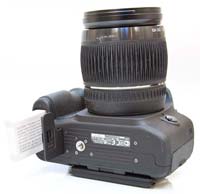 |
| Battery Compartment |
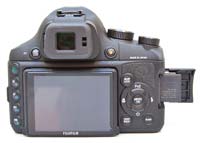 |
| Memory Card Slot |
Top-left of the LCD is a small button for swapping the display between the LCD monitor and the 0.47-inch, 1440,000 dot resolution electronic viewfinder with 100% scene coverage and surrounding eyecup. The EVF also has its own dioptric correction wheel to its immediate left, which is far less stiff and physically larger than found on competing models, meaning that for the myopic adjustment can be made in a faction of a second. The electronic viewfinder display is very large and bright and offers an excellent level of detail that surpasses most other super-zooms - it's actually so good that we used it almost exclusively in preference to the LCD screen. Another welcome addition comes in the form of a sensor which automatically switches between the EVF and viewfinder when you hold the camera up to eye-level, speeding up the transfer from using the LCD to taking a shot through the EVF. Note that this feature can be turned off if you find it annoying.
To the left of the LCD screen is a vertical column of five small buttons which provide direct access to most of the X-S1's key controls, once again mimicking the control layout of several entry-level DSLR cameras. Starting from the top, there are buttons for image playback, metering (multi pattern, spot or average), AF mode (center, multi, area or tracking), ISO speed and White Balance. All five buttons also perform actions during image playback, denoted by the blue symbols, resulting in a logical system that provides quick and easy access to most of the camera's key functions.
To the right of the screen is the previously mentioned one-touch movie record button and a self-explanatory AE/AF lock button. Below is a familiar four-way controller with a dual-purpose Menu/OK button at its centre. Ranged at north, south, east and west around this control are variously, the configurable Fn2 button, the various flash modes, the self timer options, and shifting focus from infinity to either macro or super macro. Press the Menu button in shooting mode and you get a comprehensive choice of options from two main folders., Shooting and Set-Up, with up to 6 screens containing 6 icons per screen. Most of the options are the "set once and forget" kind, so you won't have to dip into the menu system too often. Below the navigation pad is a dual-purpose control marked Display/Back that switches between the various LCD modes and also allows you to retrace your steps at any point and the RAW button which toggles RAW mode on and off.
The right hand flank of the Fujifilm X-S1 features a flip-open compartment for the SD / SDHC / SDXC card slot, while the left has a rubber flap hiding the X-S1's mini-HDMI port, the regular USB and AV out sockets,and a port for an external microphone. The base of the Fujifilm X-S1 features a screw thread for a tripod, made of metal but not in line with the lens barrel, and a sliding door hiding the compartment for the NP-95 Li-ion battery that's stored within the handgrip. Battery life is excellent at around 450 shots or 500 if you exclusively use the EVF.. There are metal loops either side of the body for attaching the provided strap.


















0 komentar:
Posting Komentar